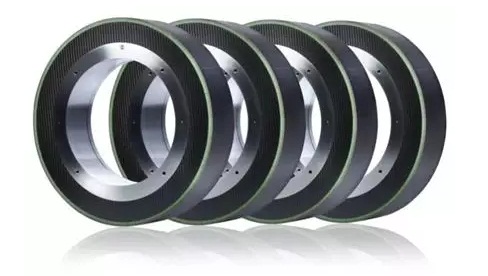It is imperative for many users to use high-performance grinding tools to efficiently produce high-value-added and high-quality parts. For this purpose, the grinding wheels take the form of a special substrate combined with an abrasive coating. The base body of the grinding wheel is generally made of steel. However, due to the excessive weight of the steel, there will be certain disadvantages in the grinding process. Today, lightweight base materials offer a more suitable solution for most grinding applications - especially in the automotive industry, the bearing industry and the medical device industry.
Pursuit of more efficient grinding with CBN grinding wheels
At this stage, improving the efficiency of the grinding process can often only be achieved by using higher hardness grinding wheels. However, grinding wheels with CBN or diamond super abrasives are much more expensive than traditional grinding wheels, such as corundum or silicon carbide grinding wheels. For this reason, such wheels tend to have only a few millimeters thick coating of the working abrasive and are attached to a metal or ceramic substrate. The base body must fulfill a series of requirements, such as absorbing vibrations, conducting heat and ensuring the stability of the grinding wheel. Therefore, grinding wheel manufacturers have always placed great emphasis on the development and production of innovative high-performance substrates.

Steel substrates are no longer optimal
For some high-performance grinding applications in the automotive industry, bearing industry and medical equipment industry, the working speed of the CBN grinding wheel may even exceed 100 m/s. For this reason, the high metal removal rate during grinding creates high mechanical loads on the grinding wheel. For these reasons, the use of steel-based CBN grinding wheels in the grinding process ensures the safety and rigidity required for the grinding process. However, the disadvantage of the steel matrix is that it has a large dead weight and is difficult to handle and load, especially for large-sized CBN grinding wheels weighing 100 kg or more, which cannot be handled and loaded by hand. Therefore, auxiliary handling and loading and unloading devices must be equipped, and the loading and unloading time is greatly increased, and the downtime is also increased accordingly. In addition, the load on the machine tool increases significantly, especially on the spindle, which ultimately leads to a shortened service life of the spindle bearings and increased maintenance costs. When the weight of the grinding wheel exceeds the load limit of the machine tool spindle, due to the principle of inertia, the spindle can no longer control the acceleration and deceleration of the grinding wheel stably, and the entire grinding process will no longer be safe. Ultimately, additional energy consumption must be added to bring the grinding wheel to the desired operating speed.
Today's preferred solution for lightweight substrates
For these grinding applications with high performance requirements, the use of a lightweight composite fiber matrix is a solution. The advantage of these carbon fiber composite materials is the combination of high specific strength and low density. Compared with the steel matrix, it perfectly solves the disadvantages of the excessive weight of the grinding wheel matrix. CBN grinding wheels with carbon fiber matrix (see the figure below) have been widely used in various crankshaft processing or gear shaft processing. When customers need large-diameter grinding wheels, or need to use multiple parallel grinding wheels for assembly, such as center less grinding process, carbon fiber matrix The advanced CBN grinding wheel will be a preferred solution.

Compared with the steel matrix, the CBN grinding wheel with carbon fiber matrix can significantly reduce the weight of the grinding wheel to more than 70%. This not only facilitates handling and loading and unloading, but also greatly reduces the load on the machine tool spindle. The carbon fiber matrix also has good vibration damping performance, which can offset the instability during the grinding process and effectively improve the quality of the grinding surface. The carbon fiber matrix can also be used in grinding tools with smaller diameters (such as medical equipment industry in some grinding applications).
Future trends in lightweight substrates
However, one disadvantage of using carbon fiber matrix is its low axial stiffness, so it can only be used in grinding processes with radial and tangential forces. In addition, acoustic emission (AE) sensors for contact detection and process control are no longer suitable on carbon fiber substrates. Based on the reasons mentioned above, as well as other reasons not mentioned, Hermes has developed a brand new grinding wheel base. This new lightweight substrate from HERMES is unique in that it is produced by a modern manufacturing process and can be tailored for different grinding applications. The design and selection of a given grinding application process is the basis for predicting and calculating grinding loads. Using finite element analysis methods, targeted strength analyzes can be carried out for different wheel base designs. In this way, it is possible to obtain a lightweight metal substrate which has been optimized for special loads. Furthermore, the metal substrate can maintain the same weight as the carbon fiber substrate, while angular plunge grinding applications and other axially loaded grinding applications become possible while maintaining the use of acoustic emission (AE )Sensing Technology.